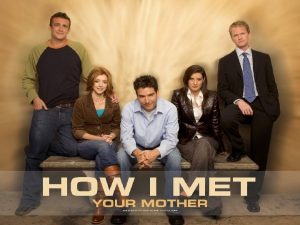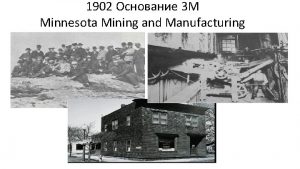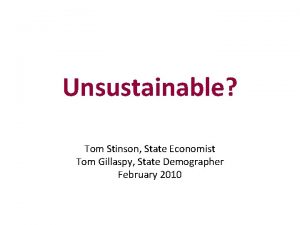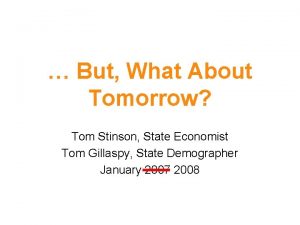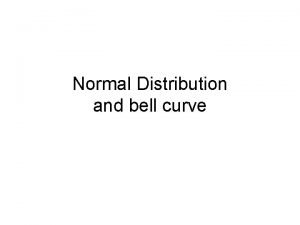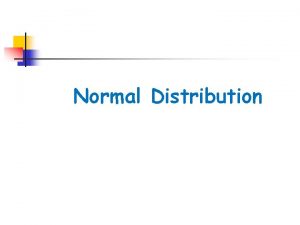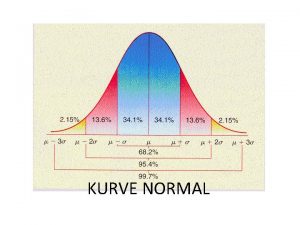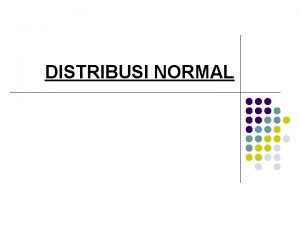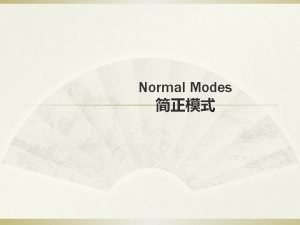Minnesota and the New Normal Tom Stinson Tom








































- Slides: 40

Minnesota and the New Normal Tom Stinson Tom Gillaspy April 2012

Minnesota’s Finances Have Improved • FY 2012 -13 budget improved by $1. 2 billion since end of session • Forecast balances used to restore reserves and buy back $313 million f school aid shift • FY 2014 -15 budget outlook shows $1. 1 billion gap between expenditures and revenues • Remaining school shift -- $2. 4 billion • Estimated inflation $1. 0 billion

Recent Economic and Demographic Events Have Changed the Outlook for as Far as We Can See

This Recovery Has Been Slower Than Those in the Past

U. S. Unemployment Rate 8. 2 Percent Employment Down 5. 2 Million Jobs

Total U. S. Wages Fell in 2009 Quarterly Year-Over-Year Percent Change

Household Wealth Fell More than $16 Trillion; Real Estate, Nearly $10 Trillion

Convergence of Population Growth Rates Census Bureau estimates, 2000 -09 aligned with 2010 Census

The Number Of Minnesotans Turning Age 65 Is Increasing Sharply This Year Census ACS and counts and Mn State Demographer forecasts, the 2012 increase is 36%

From 2010 to 2020, Minnesota Will See Large Increases Age 50 s and 60 s Source: Minnesota State Demographic Center, rev 2007 Numbers are rounded

Annual Percent Change Minnesota Total Labor Force Minnesota State Demographer forecast, revised January 2012 Gillaspy Demographics www. gilldem. com

World Labor Force Growth Slowing Projected Change In Working Age Population (15 -64) U. S. Census Bureau

Percent Of Employers Having Difficulty Filling Jobs Due To Lack Of Available Talent Manpower Group, 2011 Talent Shortage Survey Gillaspy Demographics www. gilldem. com

Minnesota Will Grow More Diverse; Remain Less Diverse Than The Nation State Demographer & Census Bureau projections

In 2006, Minnesota’s Foreign Born Workforce Was 240, 000 or 8% Of The Total Workforce 2006 ACS

The Old Normal + The Great Recession + Long Run Demographic Changes = The New Normal

The “New Normal” Probably Means • • Higher interest rates Labor and talent will be the scarce resources Slower economic growth A single-minded focus on productivity Increasing numbers of retirees A more diverse population More uncertainty about the future

For Many Occupations, Replacements Will Outnumber New Job Growth Projected Openings In Minnesota Occupations 2006 -16 DEED projections. Percent of 2006 level

Budget Pressures Will Change More 65+ Than School Age by 2020 Census counts & State Demographer projection, revised Jan 2012

Health Care Spending Jumps After 55 U. S. Health Care Spending By Age, 2004 Source: Agency for Health. Care Research and Quality, Medical Expenditure Panel Survey, data for per capita spending by age group in the Midwest. Excludes spending for long-term care institutions.

The “New Normal” Probably Means--2 • Creative destruction/disruptive innovation will change the way we deliver services • • • A shift in balance between private and public sectors A change in the land rent gradient Benefits depend on employment not employer Chronic government deficits & cuts in service Worries about how to pay for past promises A whole new set of opportunities

State Taxes Paid by a Married Couple Before and After Retirement Income Tax Sales Tax Total Change Pct Working $35, 000 $1, 236 $782 $2, 018 $65, 000 $3, 387 $1, 295 $4, 682 Retired @ 70 % $25, 000 $0 $45, 000 $1, 091 $559 -$1, 459 -72% $896 $1, 987 -$2, 695 -58%

If State Health Care Costs Continue Their Current Trend, State Spending On Other Services Can’t Grow General Fund Spending Outlook, presentation to the Budget Trends Commission, August 2008, Dybdal, Reitan and Broat

Minnesota Faces a Fiscal Trap 1. The issue is a long run, structural one— short run solutions will not solve the problem 2. Trend growth alone will not be sufficient. Fundamental changes are necessary 3. Revenue growth will slow. Efforts to increase it will be met with resistance 4. Spending pressures will increase driven largely by issues of aging and health 5. State spending will shift its focus from education, infrastructure and higher education to care and support of the aging

The Great Recession Has Been Blamed for Raising the Level of Social Angst But What Is Really Happening Is That We Have Entered A “New Normal”

But Why Fear The New Normal? It Plays To Our Strengths! Future economic growth will depend increasingly on increasing productivity and less on labor force size Education has been the key to Minnesota’s productivity and prosperity Future productivity increases will depend on decisions and the investments we make now Public Sector Productivity Growth Will Be Essential

Productivity Is Not Just Producing at a Lower Cost

Increasing Productivity Also Means Making things better (improved quality) Making better things (innovation, new products)

Focusing Just On Expenditure Cuts May Be Short Sighted Long term cost saving may require investments which increase short term expenditures

“Making Things Better” May Offer the Greatest Potential • Cost cutting efforts have focused on transactional jobs • Largest future productivity gains are likely to come from investments that lead to better outcomes Lower lifetime health care costs, reduced recidivism rates, improved graduation rates • Adapting service delivery plans to meet the needs of the “New Normal”

60% Of Minnesota K-12 Teachers Are Over Age 40 2008 ACS

3 R’s of Opportunity • Restructure government costs • Replace retiring government workers wisely • Re-engage the growing retiree population

3 More R’s Of Opportunity • Restructure government revenues • Research to solve problems—for example improved graduation rates • Restore entrepreneurship, initiative, invention in the private and public sectors

Education Achievement Gaps Are Large Minnesota High School Graduation Ratio 2009 -10 Mn Dept of Education 5 year graduation rate. Percent of 9 th graders who graduate within 5 years. ACS 2009

High School Graduation Is No Longer Enough • 70% of Minnesota job openings will require at least some college--63% nationally • In 1973, 28% of job openings required some college • Minnesota is the 3 rd most education intensive job market in the nation • Nationally, college degrees conferred will need to increase by 10% a year by 2018 to meet the demand for skilled workers and avoid slower economic growth Georgetown Univ Center for Education and The Workforce

Minnesota 2010 Earnings By Education 2010 ACS

Unemployment Rates Are highly Correlated With Education Unemployment Rates For Minnesotans Age 25 -44 2010 ACS PUMS

The Fiscal Catch-22 If we don’t make the necessary public investments in human capital, research and infrastructure, then we won’t have the productivity gains needed to provide the resources to make those investments.

“If something can't go on forever, it will stop. ” Herbert Stein, Chair President Nixon’s Council of Economic Advisors

“I skate to where the puck will be, not to where it has been. ” Wayne Gretzky Famous Canadian Philosopher
 Barney stinson heidi klum
Barney stinson heidi klum Hailey stinson
Hailey stinson Paula stinson
Paula stinson Nathan stinson
Nathan stinson Gina stinson
Gina stinson Symbolism in the devil and tom walker
Symbolism in the devil and tom walker Tom tom go 910
Tom tom go 910 Minnesota mining and manufacturing post-it
Minnesota mining and manufacturing post-it Hymen
Hymen Coaching and monitoring form
Coaching and monitoring form Hình ảnh bộ gõ cơ thể búng tay
Hình ảnh bộ gõ cơ thể búng tay Slidetodoc
Slidetodoc Bổ thể
Bổ thể Tỉ lệ cơ thể trẻ em
Tỉ lệ cơ thể trẻ em Gấu đi như thế nào
Gấu đi như thế nào Glasgow thang điểm
Glasgow thang điểm Chúa yêu trần thế alleluia
Chúa yêu trần thế alleluia Các môn thể thao bắt đầu bằng tiếng đua
Các môn thể thao bắt đầu bằng tiếng đua Thế nào là hệ số cao nhất
Thế nào là hệ số cao nhất Các châu lục và đại dương trên thế giới
Các châu lục và đại dương trên thế giới Công thức tính thế năng
Công thức tính thế năng Trời xanh đây là của chúng ta thể thơ
Trời xanh đây là của chúng ta thể thơ Mật thư tọa độ 5x5
Mật thư tọa độ 5x5 Làm thế nào để 102-1=99
Làm thế nào để 102-1=99 Phản ứng thế ankan
Phản ứng thế ankan Các châu lục và đại dương trên thế giới
Các châu lục và đại dương trên thế giới Thể thơ truyền thống
Thể thơ truyền thống Quá trình desamine hóa có thể tạo ra
Quá trình desamine hóa có thể tạo ra Một số thể thơ truyền thống
Một số thể thơ truyền thống Cái miệng nó xinh thế
Cái miệng nó xinh thế Vẽ hình chiếu vuông góc của vật thể sau
Vẽ hình chiếu vuông góc của vật thể sau Biện pháp chống mỏi cơ
Biện pháp chống mỏi cơ đặc điểm cơ thể của người tối cổ
đặc điểm cơ thể của người tối cổ Thế nào là giọng cùng tên?
Thế nào là giọng cùng tên? Vẽ hình chiếu đứng bằng cạnh của vật thể
Vẽ hình chiếu đứng bằng cạnh của vật thể Tia chieu sa te
Tia chieu sa te Thẻ vin
Thẻ vin đại từ thay thế
đại từ thay thế điện thế nghỉ
điện thế nghỉ Tư thế ngồi viết
Tư thế ngồi viết Diễn thế sinh thái là
Diễn thế sinh thái là
